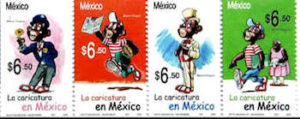
On this date in 2005, the Mexican government issued postage stamps of Memín Pingüín.
The late Yolanda Vargas Dulchéis created Memín Pingüín. Memin Pingüín is a Black comic personality whose cartoons have been published in various publications throughout Mexico and other Latin American countries since 1943. Stories feature him as a poor Afro Mexican boy, often taunted and laughed at. The original character, Memín Pingo, by some Mexicans, was changed to Pingüín when they found that the word was slang for "penis" in some countries.
Memín was first featured in the 1940s in a comic book and was later given his own magazine. The character was created by Alberto Cabrera in 1943 and was later drawn by Sixto Valencia Burgos. Burgos exaggerated the character at the instruction of Dulché. He also cites Ebony White as an influence. The original series had 372 chapters printed in sepia, and it was republished in 1952 and 1961. In 1988, it was re-edited and colorized; in 2004, it was re-edited again. Burgos continues to work on the comic, updating the drawings for the renditions.
The stories incorporate elements of comedy and soap opera. Memín, having read that Cleopatra took milk baths to lighten her skin, tries the same treatment in one issue. His mother cried because her son wanted to change his skin color. A repentant Memín decides to take pride in his race and color to honor his good mother. In another, Memín chooses not to take communion after a cruel boy tells him Blacks aren't allowed in Heaven, pointing to the lack of Black angels in religious paintings as proof. Memín reasons that, since he's going to Hell anyway, he can make any mischief he wants. This prompted some Roman Catholic priests to boycott the magazine.
After-sales plummeted, the authors and illustrators published an issue in which Memín takes communion and dreams of becoming an angel.
In addition to Mexico, Memín remains a popular magazine in Puerto Rico, Venezuela, Peru, Argentina, Chile, Panama, Colombia, the Philippines, and other countries. At its peak, it had a weekly circulation of 1.5 million issues in Mexico; as of mid-2005, it sold over 100,000 copies a week.